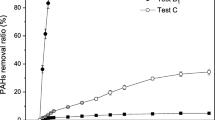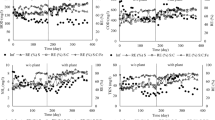Abstract
The wide use of Acetaminophen (ACT) for pain relief and lack of ability of most wastewater treatment plants to treat ACT residues have increased the risk of surface and groundwater contamination. Constructed wetlands (CW) are a low cost technology for effective wastewater treatment to treat micro-pollutants through the roles of CW media such as adsorption and Fenton reaction. This study aimed to characterize the potential of laterite soil as a CW media for ACT removal from wastewater through Fenton reaction. The experimental data showed enrichment of rhizosphere with exogenous hydrogen peroxide (H2O2) under ACT contaminant water (hospital wastewater). The contributions of plant uptake and Fenton reaction for ACT removal were found to be 0.04–1.35 and 35.34%, respectively. Media adsorption together with other factors (i.e., microbial degradation and by-product transformation) constituted about 60.76–64.61% of ACT removal. The laterite soil media coupling Fenton reaction was found promising due to advanced degradation of ACT, yielding inorganic, and less toxic final products.








Similar content being viewed by others
References
Andreozzi, R., Caprio, V., Marotta, R., & Vogna, D. (2003). Paracetamol oxidation from aqueous solutions by means of ozonation and H2O2/UV system. Water Research, 37, 993–1004.
Bader, H., Sturzenegger, V., & Hoigné, J. (1988). Photometric method for the determination of low concentrations of hydrogen peroxide by the peroxidase catalyzed oxidation of N,N-diethyl-p-phenylenediamine (DPD). Water Research, 22, 1109–1115.
Baigi, M. G., Brault, L., Néguesque, A., Beley, M., Hilali, R. E., Gaüzère, F., & Bagrel, D. (2008). Apoptosis/necrosis switch in two different cancer cell lines: influence of benzoquinone- and hydrogen peroxide-induced oxidative stress intensity, and glutathione. Toxicology In Vitro, 22, 1547–1554.
Bartha, B., Huber, C., Harpaintner, R., & Schröder, P. (2010). Effects of acetaminophen in Brassica juncea L. Czern.: investigation of uptake, translocation, detoxification, and the induced defense pathways. Environmental Science and Pollution Research, 17, 1553–1562.
Benitez, F. J., Beltran-Heredia, J., Acero, J. L., & Rubio, F. J. (2000). Contribution of free radicals to chlorophenols decomposition by several advanced oxidation processes. Chemosphere, 41, 1271–1277.
Boix, C., Ibáñez, M., Fabregat-Safont, D., Morales, E., Pastor, L., Sancho, J. V., Sánchez-Ramírez, J. E., & Hernández, F. (2016). Behaviour of emerging contaminants in sewage sludge after anaerobic digestion. Chemosphere, 163, 296–304.
Cheeseman, J. M. (2006). Hydrogen peroxide concentrations in leaves under natural conditions. Journal of Experimental Botany, 57, 2435–2444.
De Laurentiis, E., Prasse, C., Ternes, T. A., Minella, M., Maurino, V., Minero, C., Sarakha, M., Brigante, M., & Vione, D. (2014). Assessing the photochemical transformation pathways of acetaminophen relevant to surface waters: transformation kinetics, intermediates, and modelling. Water Research, 53, 235–248.
De Luna, M. D. G., Veciana, M. L., Su, C. C., & Lu, M. C. (2012). Acetaminophen degradation by electro-Fenton and photoelectro-Fenton using a double cathode electrochemical cell. Journal of Hazardous Materials, 217–218, 200–207.
De Luna, M. D. G., Briones, R. M., Su, C. C., & Lu, M. C. (2013). Kinetics of acetaminophen degradation by Fenton oxidation in a fluidized-bed reactor. Chemosphere, 90, 1444–1448.
Dos Reis, A. R., Kyuma, Y., & Sakakibara, Y. (2013). Biological Fenton’s oxidation of pentachlorophenol by aquatic plants. Bulletin of Environmental Contamination and Toxicology, 91, 718–723.
Gros, M., Rodríguez-Mozaz, S., & Barceló, D. (2013). Rapid analysis of multiclass antibiotic residues and some of their metabolites in hospital, urban wastewater and river water by ultra-high-performance liquid chromatography coupled to quadrupole-linear ion trap tandem mass spectrometry. Journal of Chromatography A, 1292, 173–188.
Huguet, M., Simon, V., & Gallard, H. (2014). Transformation of paracetamol into 1,4-benzoquinone by a manganese oxide bed filter. Journal of Hazardous Materials, 271, 245–251.
Inagaki, Y., Cong, V. H., & Sakakibara, Y. (2016). Identification and application of Phyto-Fenton reactions. Chemosphere, 144, 1443–1450.
Kadam, A. M., Nemade, P. D., Oza, G. H., & Shankar, H. S. (2009). Treatment of municipal wastewater using laterite-based constructed soil filter. Ecological Engineering, 35, 1051–1061.
Katsoyiannis, I. A., Canonica, S., & von Gunten, U. (2011). Efficiency and energy requirements for the transformation of organic micropollutants by ozone, O3/H2O2 and UV/ H2O2. Water Research, 45(13), 3811–3822.
Khataee, A., Salahpour, F., Fathinia, M., Seyyedi, B., & Vahid, B. (2015). Iron rich laterite soil with mesoporous structure for exogenous Fenton-like degradation of an azo dye under visible light. Journal of Industrial and Engineering Chemistry, 26, 129–135.
Kim, I., & Tanaka, H. (2009). Photodegradation characteristics of PPCPs in water with UV treatment. Environment International, 35, 793–802.
Li, J., Ye, Q., & Gan, J. (2014a). Degradation and transformation products of acetaminophen in soil. Water Research, 49, 44–52.
Li, Y., Zhu, G., Ng, W. J., & Tan, S. K. (2014b). A review on removing pharmaceutical contaminants from wastewater by constructed wetlands: Design, performance and mechanism. Science of the Total Environment, 468–469, 908–932.
Lin, A. Y. C., Lin, C. A., Tung, H. H., & Chary, N. S. (2010). Potential for biodegradation and sorption of acetaminophen, caffeine, propranolol and acebutolol in lab-scale aqueous environments. Journal of Hazardous Materials, 183, 242–250.
Lin, Y. L., Chiou, J. H., & Lee, C. H. (2014). Effect of silica fouling on the removal of pharmaceuticals and personal care products by nanofiltration and reverse osmosis membranes. Journal of Hazardous Materials, 277, 102–109.
Luo, Y., Guo, W., Ngo, H. H., Nghiem, L. D., Hai, F. I., Zhang, J., Liang, S., & Wang, X. C. (2014). A review on the occurrence of micropollutants in the aquatic environment and their fate and removal during wastewater treatment. Science of the Total Environment, 473–474, 619–641.
Lv, T., Zhang, Y., Zhang, L., Carvalho, P. N., Arias, C. A., & Brix, H. (2016). Removal of the pesticides imazalil and tebuconazole in saturated constructed wetland mesocosms. Water Research, 91, 126–136.
Manu, B., & Mahamood. (2011). Degradation of paracetamol in aqueous solution by Fenton oxidation and photo-Fenton oxidation processes using iron from laterite soil as catalyst. International Journal of Research in Chemistry and Environment, 4, 1103–1110.
Meredith-Williams, M., Carter, L. J., Fussell, R., Raffaelli, D., Ashauer, R., & Boxall, A. B. A. (2012). Uptake and depuration of pharmaceuticals in aquatic invertebrates. Environmental Pollution, 165, 250–258.
Moctezuma, E., Leyva, E., Aguilar, C. A., Luna, R. A., & Montalvo, C. (2012). Photocatalytic degradation of paracetamol: Intermediates and total reaction mechanism. Journal of Hazardous Materials, 243, 130–138.
Phong, V. H. N., Koottatep, T., Chapagain, S. K., Panuvatvanich, A., Polprasert, C., & Ahn, K. H. (2016). Removal of acetaminophen from wastewater by constructed wetlands with Scirpus validus. Environmental Engineering Research, 21, 164–170.
Postigo, C., & Richardson, S. D. (2014). Transformation of pharmaceuticals during oxidation/disinfection processes in drinking water treatment. Journal of Hazardous Materials, 279, 461–475.
Shenker, M., Harush, D., Ben-Ari, J., & Chefetz, B. (2011). Uptake of carbamazepine by cucumber plants—A case study related to irrigation with reclaimed wastewater. Chemosphere, 82, 905–910.
Su, C. C., Chang, A. T., Bellotindos, L. M., & Lu, M. C. (2012). Degradation of acetaminophen by Fenton and electro-Fenton processes in aerator reactor. Separation and Purification Technology, 99, 8–13.
Su, C. C., Bellotindos, L. M., Chang, A. T., & Lu, M. C. (2013). Degradation of acetaminophen in an aerated Fenton reactor. Journal of the Taiwan Institute of Chemical Engineers, 44, 310–316.
Tabtong, W., Boontanon, S. K., & Boontanon, N. (2015). Fate and risk assessment of perfluoroalkyl substances (PFASs) in water treatment plants and tap water in Bangkok, Thailand. Procedia Environmental Sciences, 28, 750–757.
Trovó, A. G., Pupo Nogueira, R. F., Agüera, A., Fernandez-Alba, A. R., & Malato, S. (2012). Paracetamol degradation intermediates and toxicity during photo-Fenton treatment using different iron species. Water Research, 46, 5374–5380.
USEPA. (2000). Manual: Constructed Wetlands Treatment of Municipal Wastewaters. (Publication No. EPA/625/R-99/010). Office of Research and Development Cincinnati, Environmental Protection Agency, Ohio, US.
Valcárcel, Y., González Alonso, S., Rodríguez-Gil, J. L., Gil, A., & Catalá, M. (2011). Detection of pharmaceutically active compounds in the rivers and tap water of the Madrid region (Spain) and potential ecotoxicological risk. Chemosphere, 84, 1336–1348.
Verlicchi, P., & Zambello, E. (2014). How efficient are constructed wetlands in removing pharmaceuticals from untreated and treated urban wastewaters? A review. Science of the Total Environment, 470–471, 1281–1306.
Xiao, H., Song, H., Xie, H., Huang, W., Tan, J., & Wu, J. (2013). Transformation of acetaminophen using manganese dioxide—mediated oxidative processes: reaction rates and pathways. Journal of Hazardous Materials, 250–251, 138–146.
Xu, J., Wu, L., Chen, W., & Chang, A. C. (2008). Simultaneous determination of pharmaceuticals, endocrine disrupting compounds and hormone in soils by gas chromatography-mass spectrometry. Journal of Chromatography A, 1202, 189–195.
Zhang, D. Q., Hua, T., Gersberg, R. M., Zhu, J., Ng, W. J., & Tan, S. K. (2013). Carbamazepine and naproxen: Fate in wetland mesocosms planted with Scirpus validus. Chemosphere, 91, 14–21.
Zhang, D., Gersberg, R. M., Ng, W. J., & Tan, S. K. (2014). Removal of harmaceuticals and personal care products in aquatic plant-based systems: a review. Environmental Pollution, 184, 620–639.
Acknowledgements
Authors would like to acknowledge Korea Institute of Science and Technology (KIST), Republic of Korea for financial assistance; Mahidol University (MU) for their laboratory support, and Thammasat University hospital, Thailand for providing wastewater. The support of NATS lab staff is duly appreciated.
Author information
Authors and Affiliations
Corresponding author
Rights and permissions
About this article
Cite this article
Koottatep, T., Phong, V.H.N., Chapagain, S.K. et al. Potential of Laterite Soil Coupling Fenton Reaction in Acetaminophen (ACT) Removal in Constructed Wetlands. Water Air Soil Pollut 228, 283 (2017). https://doi.org/10.1007/s11270-017-3454-x
Received:
Accepted:
Published:
DOI: https://doi.org/10.1007/s11270-017-3454-x




